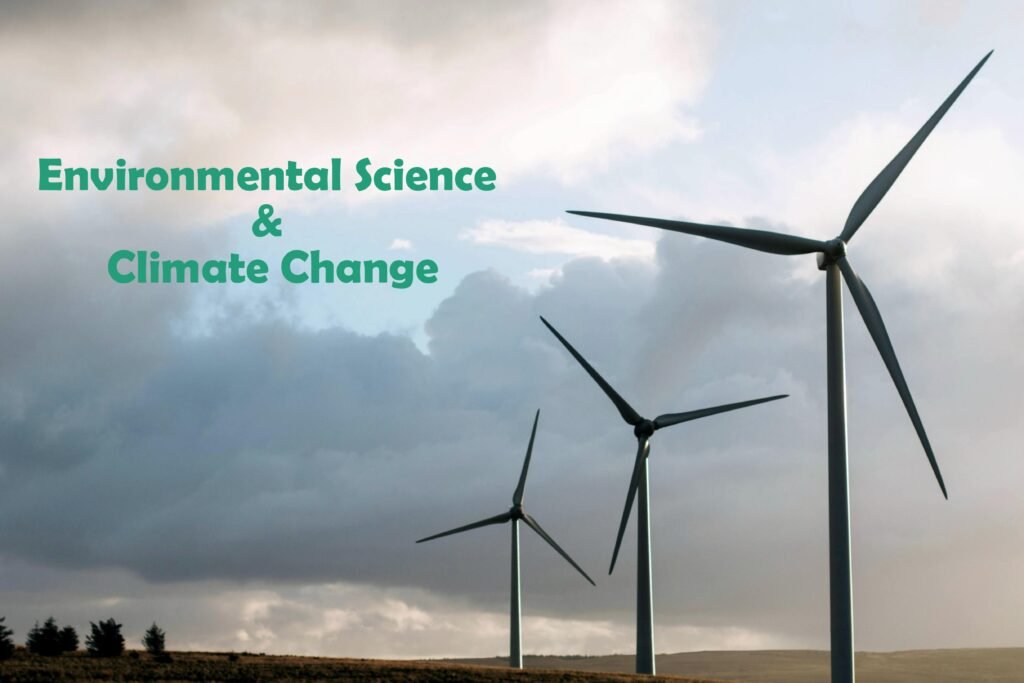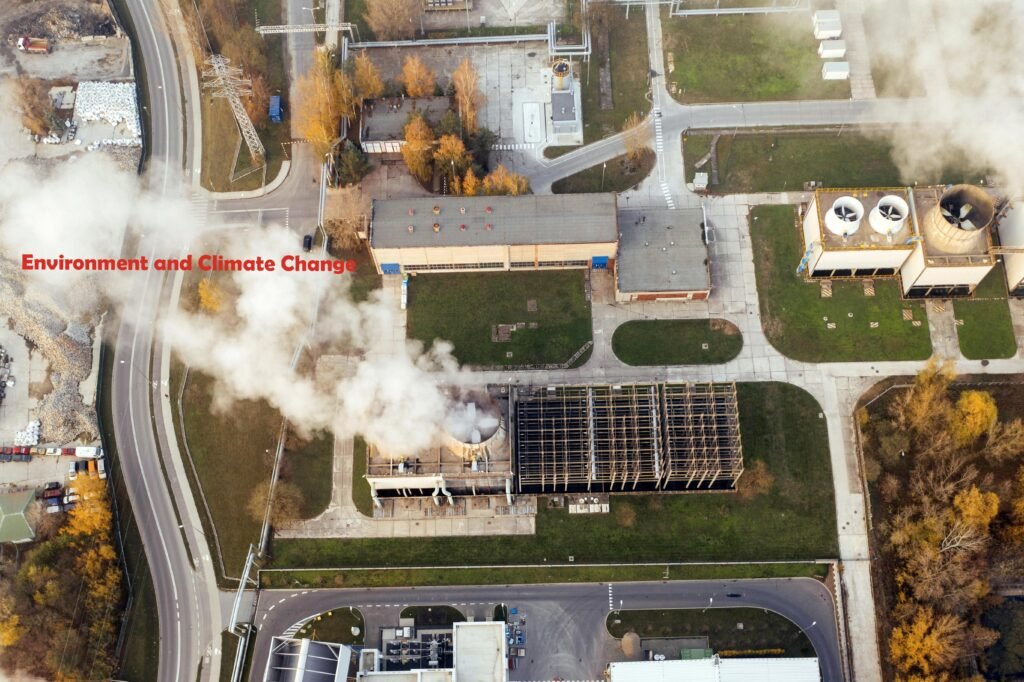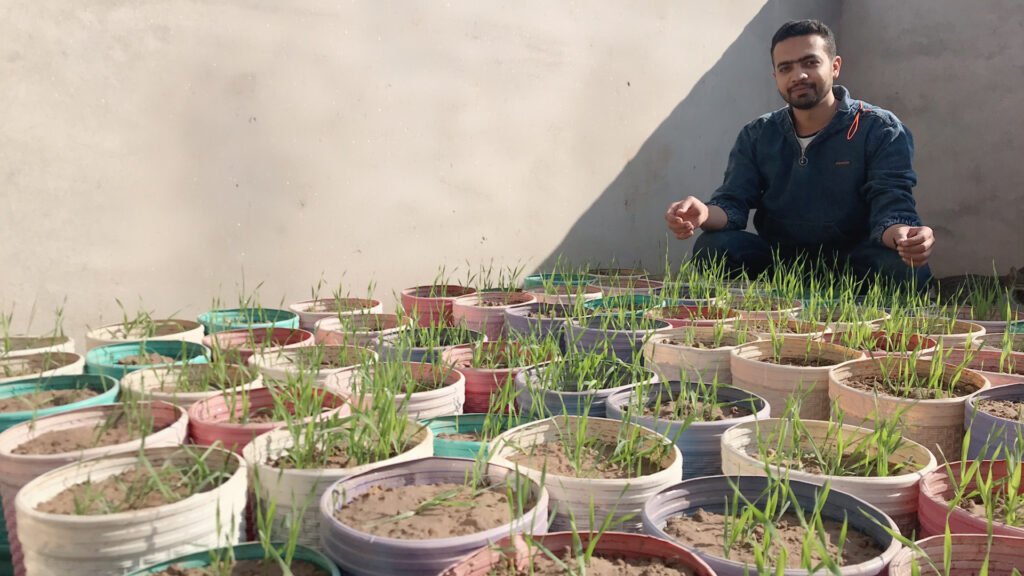Environment Sciences & Climate Change : A Unique Relation
October 31, 2024 | by gohar.ayub714@gmail.com

Environmental science and climate change are related disciplines that tackle some of the most important issues impacting humanity. The study of the natural world and how human activity affects ecosystems, biodiversity, and natural resources is known as environmental science.

Climate change, on the other hand, focuses on changes in the Earth’s climate, particularly those induced by human activities. Both fields are crucial for scientists, politicians, and individuals to understand how human activity affects the environment. As the effects of climate change become more apparent, the importance of environmental science and related policies has never been more significant.
The Importance of Environmental Science
Environmental science is a multidisciplinary field encompassing biology, chemistry, ecology, geology, and physics. It investigates how natural and human systems interact, emphasizing sustainability and conservation. Environmental scientists study phenomena such as pollution, deforestation. Resource depletion to understand their causes, effects, and solutions.

Key Areas of Environmental Science:
- Ecology: Ecology focuses on the relationships between living organisms and their environments. It examines ecosystems and food chains. With climate change disrupting ecosystems worldwide, ecology plays a crucial role in understanding these shifts.
- Biodiversity and Conservation: Biodiversity is the variety of life on Earth, encompassing all species, ecosystems, and genetic diversity. Conservation biology works to protect biodiversity, as many species face extinction due to habitat loss, pollution, and climate change. Healthy biodiversity supports resilient ecosystems that provide food, water, and clean air.
- Pollution and Waste Management: Pollution contaminates air, water, and soil, posing severe health risks to humans and wildlife. Effective waste management strategies are essential for reducing pollution, and environmental science seeks to innovate sustainable solutions such as recycling, waste-to-energy systems, and biodegradable materials.
- Natural Resource Management: The sustainable use of natural resources is essential for maintaining ecological balance. Environmental scientists focus on renewable resources (like water and forests) and non-renewable resources (like fossil fuels) to minimize depletion and encourage alternatives.
- Climate Science: Climate science, a subset of environmental science, focuses on understanding the Earth’s climate system. Studying climate patterns, greenhouse gases, and atmospheric changes helps scientists predict the impacts of climate change.
The Role of Climate Change

Climate change refers to long-term shifts in global temperatures and weather patterns, primarily driven by human activities such as burning fossil fuels, deforestation, and industrial processes. Additionally these actions increase the concentration of greenhouse gases in the atmosphere, trapping heat and altering the Earth’s climate.
Impacts of Climate Change:
- Global Temperature Rise: One of the most evident impacts of climate change is the increase in global temperatures. According to scientific data, the Earth’s average surface temperature has risen by about 1.1°C since the late 19th century. Rising temperatures lead to heatwaves, droughts, and increased energy demands, putting stress on infrastructure and ecosystems.
- Melting Ice and Rising Sea Levels: The warming climate causes glaciers and polar ice caps to melt, leading to rising sea levels. This has profound implications for coastal cities and island nations, as higher sea levels increase the risk of flooding, erosion, and habitat loss.
- Extreme Weather Events: Climate change intensifies extreme weather patterns, resulting in more frequent and severe hurricanes, floods, wildfires, and droughts. These events cause extensive damage to infrastructure, agriculture, and ecosystems, with significant economic and social costs.
- Impacts on Ecosystems and Biodiversity: Rising temperatures and changing precipitation patterns disrupt ecosystems, pushing species out of their natural habitats and leading to loss of biodiversity. Coral reefs, for example, face coral bleaching due to warmer oceans, impacting marine life and the communities that rely on it.
- Public Health Concerns: Climate change also affects public health, with extreme temperatures leading to heat-related illnesses and worsening air quality causing respiratory diseases. Vector-borne diseases such as malaria and dengue fever are spreading to new areas as climate conditions shift.
Environmental Science and Mitigation Strategies
To combat climate change, environmental science offers various strategies aimed at reducing greenhouse gas emissions, promoting sustainable practices, and adapting to changing conditions.

Key Mitigation Strategies:
- Renewable Energy: Transitioning from fossil fuels to renewable energy sources like solar, wind, and hydropower is essential for reducing greenhouse gas emissions. Renewable energy provides cleaner alternatives and reduces dependence on finite resources. likewise
- Carbon Capture and Storage (CCS): CCS technology captures carbon dioxide emissions from power plants and industrial sources, storing it underground to prevent its release into the atmosphere. This method has the potential to mitigate emissions from sectors that rely on fossil fuels. moreover
- Afforestation and Reforestation: Planting trees and restoring forests are effective ways to absorb carbon dioxide from the atmosphere. Forests act as carbon sinks, helping to offset emissions while also preserving biodiversity and ecosystem services. as well as
- Sustainable Agriculture: Agriculture is a significant contributor to greenhouse gas emissions, particularly methane and nitrous oxide. Sustainable practices, such as crop rotation, reduced pesticide use, and organic farming, can reduce emissions and protect soil health. similarly
- Improved Public Transport and Electrification: Reducing vehicle emissions through public transportation, cycling infrastructure, and electric vehicles can significantly lower emissions from the transportation sector, one of the largest sources of greenhouse gases. in contrast
- Waste Management and Recycling: Reducing, reusing, and recycling waste can reduce methane emissions from landfills. Composting organic waste also helps return nutrients to the soil, promoting sustainable agriculture.
Adaptation Strategies and Environmental Science
While mitigation aims to reduce the causes of climate change, adaptation strategies address the changes that are already occurring. Environmental science informs these strategies. Furthermore helping communities prepare for the impacts of climate change and protect ecosystems.
Key Adaptation Strategies:
- Building Resilient Infrastructure: Designing infrastructure that can withstand extreme weather events, such as storm-resistant buildings and flood barriers, helps communities adapt to climate risks.
- Water Management: Climate change affects water availability, requiring efficient water management practices. Desalination, rainwater harvesting, and improved irrigation techniques can help conserve water resources.
- Agricultural Adaptation: Farmers can adopt climate-resilient crops, adjust planting schedules, and use efficient irrigation techniques to adapt to changing climate conditions.
- Wildlife Conservation and Protected Areas: Preserving natural habitats and creating protected areas for endangered species helps maintain biodiversity and protect ecosystems from climate impacts.
- Community Education and Engagement: Educating communities about climate risks and sustainable practices empowers individuals to make informed decisions. Community engagement also encourages local solutions tailored to specific climate challenges.

The Role of Policy and International Agreements
Policies and international agreements play a critical role in addressing climate change on a global scale. Environmental science provides the data and insights necessary for effective policy-making, supporting global efforts to mitigate and adapt to climate impacts.

Key International Agreements:
- Paris Agreement (2015): The Paris Agreement aims to limit global warming to well below 2°C, with an aspirational target of 1.5°C. Countries commit to reducing emissions and reporting progress, with financial support for developing nations to adapt to climate impacts.
- Kyoto Protocol (1997): The Kyoto Protocol was an earlier agreement focused on reducing greenhouse gas emissions, primarily from developed nations. Though it has since been replaced by the Paris Agreement, it laid the groundwork for global climate action.
- Montreal Protocol (1987): While not specifically focused on climate change, the Montreal Protocol successfully reduced ozone-depleting substances. It has indirectly contributed to climate action, as many ozone-depleting substances are also potent greenhouse gases.
- Sustainable Development Goals (SDGs): The United Nations’ SDGs include goals related to climate action, clean water, and sustainable cities. These goals provide a framework for countries to work toward a sustainable future.
- Nationally Determined Contributions (NDCs): Under the Paris Agreement, countries submit NDCs outlining their emission reduction targets and adaptation plans. NDCs help track progress and ensure accountability.
The Future of Environmental Science and Climate Change
As climate challenges evolve, so too must the field of environmental science. Future advancements in technology, data analysis, and policy will be crucial for addressing complex environmental issues. Key areas for future research and development include:
- Climate Modeling and Prediction: Improved climate models will help scientists predict regional climate impacts, allowing for more targeted adaptation strategies.
- Artificial Intelligence and Big Data: AI and big data can enhance environmental monitoring, optimize resource management, and improve efficiency in energy use and waste reduction.
- Green Technology and Innovation: Emerging technologies, such as green hydrogen and biofuels, have the potential to reduce emissions and provide sustainable alternatives to fossil fuels.
- Ecosystem Restoration: Rebuilding degraded ecosystems will support biodiversity and carbon sequestration, helping to mitigate and adapt to climate impacts.
Conclusion
Environmental science and climate change are fields that demand urgent attention and action. By understanding the complex interactions between human activity and the environment, scientists, policymakers, and communities can work together to mitigate climate change, adapt to its impacts, and protect our planet’s precious resources. Whether through individual efforts or collective action, addressing environmental challenges requires a commitment to sustainability, innovation, and resilience. As we move toward a more sustainable future, environmental science remains a guiding force in the journey toward a healthier, more resilient planet.
For more Blog Like this Visit here
Extremely Hot and Strong Times Caused by Climate Change – Strnger Environment
18 Sustainability Blogs You Should Definitely Follow in 2024 – GreenCitizen
RELATED POSTS
View all



